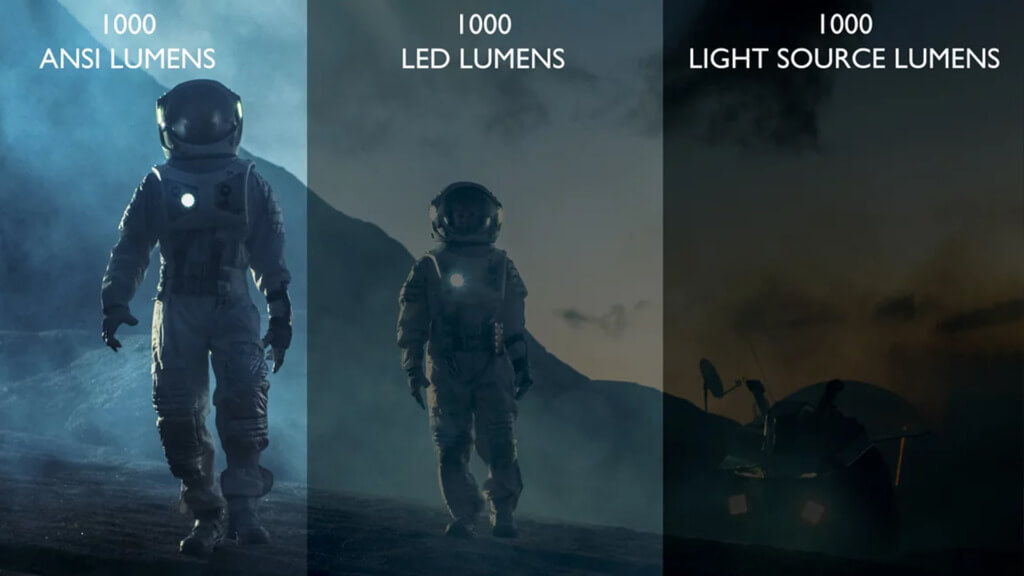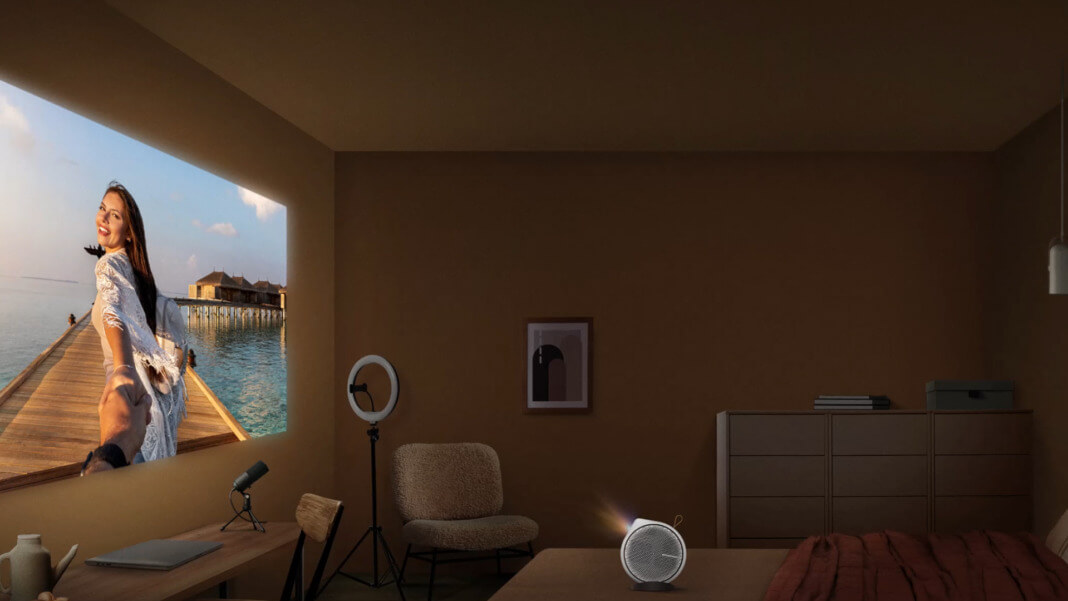Venturing into the home projector scene feels akin to navigating a fantastical galaxy filled with awe-inspiring spectacles and a sprinkle of mysteries waiting to be solved. As more individuals yearn to replicate the enchanting allure of cinemas within their own four walls, it’s inevitable to encounter intriguing terms that sound straight out of a sci-fi novel. ‘Lumens’ stands tall among them. While seemingly mystifying, this term is key to a perfect movie-watching ambience. At its heart, lumens measure brightness. Yet, the adventure begins by deciphering the right amount for your space.
Imagine lumens as the dazzling charisma of a projector. Like stars that vary in brightness in the night sky, projectors have their own luminance, determined by their lumen count. A high lumen value ensures your favourite films radiate with clarity and brilliance, even in rooms kissed by daylight. Conversely, a projector with fewer lumens might give you a faded, spectral-like display if used in bright conditions. It’s like trying to spot a distant star on a city night – the glow is there, but the surrounding light overshadows it. So, when exploring the cinematic cosmos of home projectors, remember to let lumens be your guiding star.
Demystifying the role of lumens
Lumens, in the world of projectors, are akin to the heartbeat of the device – dictating its power to breathe life into visuals with brightness; for anyone wishing to transform their living space into a mini-cinema, understanding the importance of lumens is paramount. Why? Because lumens give insight into how vividly a projector can display images, particularly when ambient light tries to steal the show. Everyone has had that slightly frustrating experience of trying to watch a projected movie in a sunlit room only to find the visuals dulled due to insufficient lumens.
Let’s draw a parallel to illustrate this concept. Picture lumens as the headlights of a car. Venture into a pitch-dark alleyway; even the most unremarkable, dim headlights become the heroes, cutting through the darkness. Now, place those same headlights under the radiant canvas of a sun-drenched day, and their glow may seem almost inconspicuous. This analogy aptly captures the dynamic nature of a projector’s lumens, which have their brilliance altered by the surrounding light conditions.
But how does one gauge the right amount of lumens for their room? The ambient light present plays a central role in this decision. If your room is a cascade of natural light streaming in from grand windows, you’re looking at a setting that craves a projector with a robust lumen count. On the flip side, rooms shrouded in shadows or specially designed home theatres with controlled lighting can achieve cinematic perfection with projectors that boast a modest lumen figure. In essence, striking the right balance between lumens and ambient light ensures that every frame projected is a masterpiece of clarity and colour.
Crafting the ideal viewing experience

The ultimate cinematic atmosphere is a delicate balance of lumens, screen size, and projector positioning. Each element is interconnected, and understanding their synergy is crucial for optimising your viewing experience.
Starting with the environment, if you’re tailoring a cinematic mood in a snug, dimly-lit setting, a projector with a brightness of 1,000 to 1,200 lumens is your ideal companion. As the space expands and basks in more ambient light, such as in a moderately illuminated living room, your focus should shift to projectors offering lumens in the range of 1,500 to 2,500. The splendour calls for a device with no less than 3,000 lumens for sprawling spaces kissed by generous sunlight or potent room lighting. This ensures the cinematic vibrancy remains undeterred, irrespective of external light sources.
| Room Setting | Ideal Lumens |
|---|---|
| Dimly-lit room | 1,000 – 1,200 |
| Room with some ambient light | 1,500 – 2,500 |
| Bright spaces | > 3,000 |
However, room lighting is just one piece of the puzzle. The magnitude of your chosen screen plays an equally cardinal role in determining the lumen requirement. For instance, should you opt for a screen measuring 9×5 ft., your daytime projections would be best served with at least 2,300 lumens, while evening showings would necessitate around 1,500 lumens. Upgrade to a majestic 20×11 ft display, and you’re looking at a daytime requirement of 7,500 lumens, which can be toned down to 4,500 lumens come nightfall.
Finally, let’s factor in the intricate dance between the projector and the screen. The distance from each other can significantly influence brightness and clarity. The rule of thumb here is straightforward: the further the projector sits from the screen, the more lumens it must boast. Fortunately, this is an aspect that offers flexibility. Adjusting the position of your projector, either drawing it closer for more intimate settings or letting it claim a farther spot for expansive displays, allows you to modulate the brilliance on the screen until it’s both bright and lucid.
ANSI Lumen vs Lumen
At the heart of the matter is the concept of brightness. ANSI lumens, endorsed by the American National Standards Institute, serve as a reliable and standardised unit for gauging the brightness of projectors. When you come across this term, you can trust that it offers an industry-standard measurement.
LED lumens, on the other hand, are specific to LED-based projectors. One can multiply the ANSI lumen value by 2.4 for conversion to arrive at the LED lumen value. For instance, if a projector boasts 50 ANSI lumens, this translates to 120 LED lumens. Similarly, a rating of 1,000 ANSI lumens would equate to 2,400 LED lumens.
ANSI Lumen x 2.4 = Lumen
Then there are light source lumens, which measure the intensity of the light source itself, usually more potent than what is projected on the screen. To convert ANSI lumens to light source lumens, one multiplies the ANSI value by 16. Hence, 50 ANSI lumens become 800 light source lumens, and 1,000 ANSI lumens magnify to an impressive 16,000 light source lumens.
The journey is a two-step process for those looking to convert between LED lumens and light source lumens. First, one would convert the LED lumens back to ANSI lumens by dividing by 2.4. Once in possession of the ANSI value, the conversion to light source lumens requires a multiplication of 16.
While this may appear to be a cascade of numbers, the essence is simple: it’s all about ensuring you clearly understand the brightness your projector offers. With this knowledge, you’re better poised to select a projector that will illuminate your cinematic experiences brilliantly.
Does high lumens mean excellent viewing quality?
From the discussions centred around lumens, one might easily assume that high brightness universally translates to outstanding viewing quality. However, the reality is more nuanced. While a projector with intense brightness might seem like a versatile solution for various projection sizes and ambient lighting, it doesn’t guarantee impeccable image clarity paired with vibrant colour.
For home theatre enthusiasts, the recommendation is clear: seek a projector that provides the right brightness level. This ensures the crispest images and the most optimal colour performance and contrast ratio. Merely chasing the highest lumen count without context can be a misstep.
Delving deeper into the technicalities, the light processing elements of a projector primarily hinge on two components: the projection lamp and the colour wheel. The projection lamp is pivotal, influencing the projector’s maximum brightness potential. On the other hand, the colour wheel is the sentinel of colour performance, guiding the accurate representation of the RGB spectrum.
A lamp with a higher wattage should yield a brighter image. Simultaneously, the purity of the colour wheel’s RGB components needs meticulous calibration to ensure the accurate reproduction of colours. However, this relationship is rife with trade-offs. Light transmission, and therefore brightness, will be compromised when it is necessary to meet pure colour requirements. So, instead of pursuing high lumens, projection brightness must be controlled within an appropriate range to increase colour accuracy.
While lumens are central to projector performance, an indiscriminate pursuit of high brightness can be counterproductive. The art lies in discerning the right balance, securing a visual experience that’s both luminous and rich in colour.





